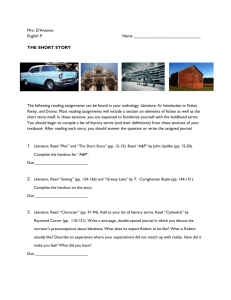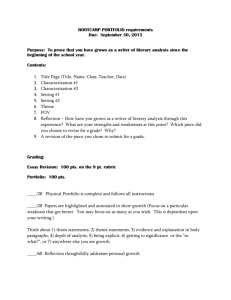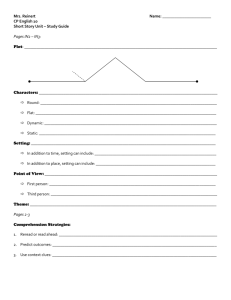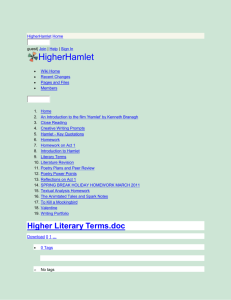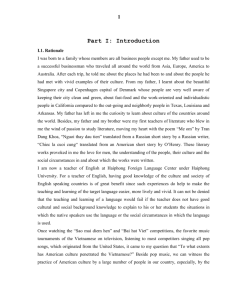long lit analysis-fiction-drama-poetry 2015 - Lake
advertisement
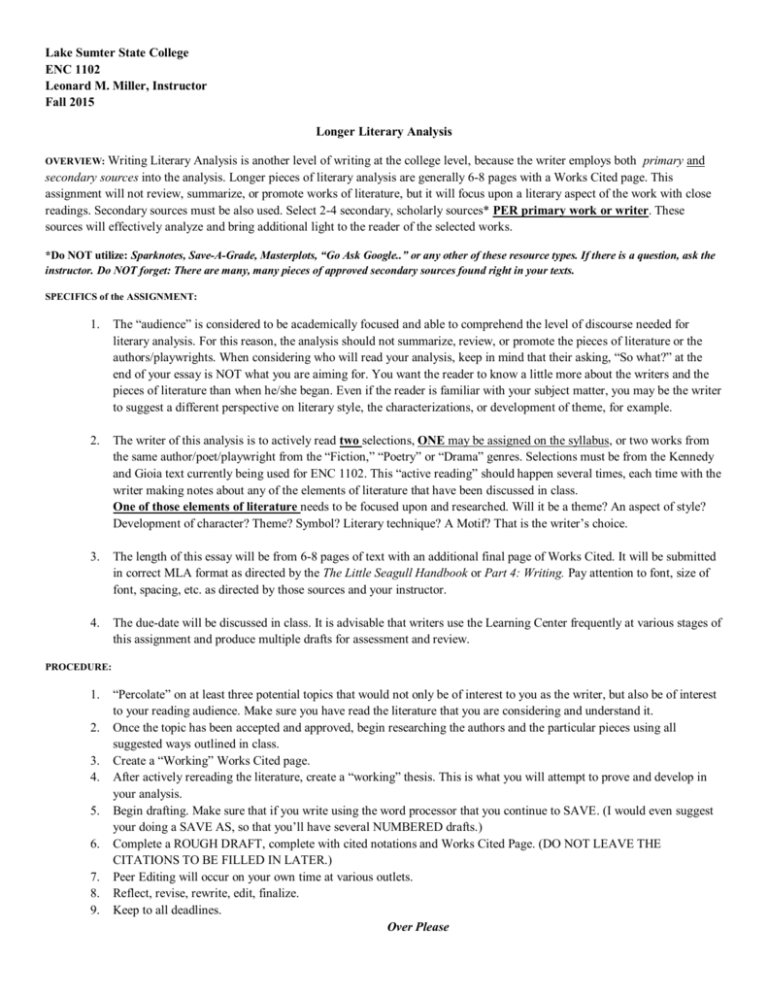
Lake Sumter State College ENC 1102 Leonard M. Miller, Instructor Fall 2015 Longer Literary Analysis OVERVIEW: Writing Literary Analysis is another level of writing at the college level, because the writer employs both primary and secondary sources into the analysis. Longer pieces of literary analysis are generally 6-8 pages with a Works Cited page. This assignment will not review, summarize, or promote works of literature, but it will focus upon a literary aspect of the work with close readings. Secondary sources must be also used. Select 2-4 secondary, scholarly sources* PER primary work or writer. These sources will effectively analyze and bring additional light to the reader of the selected works. *Do NOT utilize: Sparknotes, Save-A-Grade, Masterplots, “Go Ask Google..” or any other of these resource types. If there is a question, ask the instructor. Do NOT forget: There are many, many pieces of approved secondary sources found right in your texts. SPECIFICS of the ASSIGNMENT: 1. The “audience” is considered to be academically focused and able to comprehend the level of discourse needed for literary analysis. For this reason, the analysis should not summarize, review, or promote the pieces of literature or the authors/playwrights. When considering who will read your analysis, keep in mind that their asking, “So what?” at the end of your essay is NOT what you are aiming for. You want the reader to know a little more about the writers and the pieces of literature than when he/she began. Even if the reader is familiar with your subject matter, you may be the writer to suggest a different perspective on literary style, the characterizations, or development of theme, for example. 2. The writer of this analysis is to actively read two selections, ONE may be assigned on the syllabus, or two works from the same author/poet/playwright from the “Fiction,” “Poetry” or “Drama” genres. Selections must be from the Kennedy and Gioia text currently being used for ENC 1102. This “active reading” should happen several times, each time with the writer making notes about any of the elements of literature that have been discussed in class. One of those elements of literature needs to be focused upon and researched. Will it be a theme? An aspect of style? Development of character? Theme? Symbol? Literary technique? A Motif? That is the writer’s choice. 3. The length of this essay will be from 6-8 pages of text with an additional final page of Works Cited. It will be submitted in correct MLA format as directed by the The Little Seagull Handbook or Part 4: Writing. Pay attention to font, size of font, spacing, etc. as directed by those sources and your instructor. 4. The due-date will be discussed in class. It is advisable that writers use the Learning Center frequently at various stages of this assignment and produce multiple drafts for assessment and review. PROCEDURE: 1. 2. 3. 4. 5. 6. 7. 8. 9. “Percolate” on at least three potential topics that would not only be of interest to you as the writer, but also be of interest to your reading audience. Make sure you have read the literature that you are considering and understand it. Once the topic has been accepted and approved, begin researching the authors and the particular pieces using all suggested ways outlined in class. Create a “Working” Works Cited page. After actively rereading the literature, create a “working” thesis. This is what you will attempt to prove and develop in your analysis. Begin drafting. Make sure that if you write using the word processor that you continue to SAVE. (I would even suggest your doing a SAVE AS, so that you’ll have several NUMBERED drafts.) Complete a ROUGH DRAFT, complete with cited notations and Works Cited Page. (DO NOT LEAVE THE CITATIONS TO BE FILLED IN LATER.) Peer Editing will occur on your own time at various outlets. Reflect, revise, rewrite, edit, finalize. Keep to all deadlines. Over Please Suggested Topics: (These are ONLY to get you thinking. Try thinking of one yourself based on your likes when it comes to genre and/or author.) Suggested Topics for Thematic Essays: Do NOT use any of these suggestions for TITLES. Please think of your own; creativity and originality counts! 1. A Look at the Parent/Child Relationship : Drama: Death of a Salesman; Fences; Hamlet etc. Short Fiction: “Everyday Use,” Luke 15:11-32 “The Parable of the Prodigal Son;” “Teenage Wasteland,” “This is What It Means to Say Phoenix, Arizona,”“The Shunammite,” “Barn Burning,” etc. Poetry: “My Papa’s Waltz,” “For My Daughter,” “Rite of Passage,” “Daddy” etc. 2. Love and Marriage: Eternal Bliss or Damnation? Drama: A Doll’s House; A Midsummer’s Night Dream; Death of a Salesman; Tattoo; Soap Opera; etc. Short Fiction: “Shiloh;” “Happy Endings;” “Sweat;” “Araby;” “A Place I’ve Never Been;” “The Chrysanthemums;” “How I Met My Husband;” “I Stand Here Ironing;” “Miss Brill;” etc. Poetry: “My Last Duchess;” “Lonely Hearts;” “Love Calls Us to the Things of this World;” “Love and Friendship;” etc. “Oh, my love is like a red, red rose;” “First Love: A Quiz;” “The Love Song of J. Alfred Prufrock;” “Shall I Compare Thee to a Summer’s Day?” “The Heart;” “You fit into me;” “Deathly;” etc. 3. Forever Friends or Bitter Enemies: Brothers/Sisters in Our Lives Drama: Death of a Salesman; Antigone; Hamlet; Othello; etc. Short Fiction: “Everyday Use;” “The Rich Brother;” “The Fall of the House of Usher;” etc. Poetry: “On the Death of Friends in Childhood;” etc. Miscellaneous Suggestions: 1. Choose and read two stories from the section in “Fiction.” After briefly summarizing plot and characterization, write at length about how the protagonist is changed or tested by the story’s events. What do the main characters’ actions reveal about his/her personality? Possible selections: “Everyday Use;” “Young Goodman Brown;” “A Rose for Emily;” A Good Man is Hard to Find;” “Parker’s Back;” “Paul’s Case;” “Sweat;” “The Rich Brother;” etc. 2. Take any story in this chapter and analyze how the author presents the key setting. Don’t pay special attention to the protagonist or other human characters, but focus on the setting that surrounds him/her and how it emerges as a force in the story. 3. Examine a short story with a style you admire. Analyze the author’s approach toward diction, sentence structure, tone, and organization. How do these elements work together to create a certain mood? How does that mood contribute to the story’s meaning? If your chosen story has a first-person narrator, how do stylistic choices help to create a sense of that particular character? 4. “To Build a Fire” and “The Open Boat” both address the theme of a human being pitted against indifferent nature. Contrast the stories’ approaches to this theme. How do the tones of the stories differ? How do these tonal differences help to communicate theme? 5. Choose a story with a strong central symbol. Explain how the symbol helps to communicate the story’s meaning, citing specific moments in the text. Refer to any the ancillary material in your text for assistance. 6. Compare Oedipus the King to Antigone in terms of their characterizations of their protagonists. In what ways does Antigone resemble Oedipus, and in what ways does she differ? Is either or both consider tragic heroes? 7. Discuss how any, or both, of these Shakespearean characters are tragic heroes: Hamlet and/or Othello. You might want to contrast the characters: Hamlet: the procrastinating son/boyfriend and Othello: the impulsive lover/best friend. 8. Select at least five poems by the same poet (1 or 2 may be found outside the text, if need be) and discuss the poet’s poetic style and thematic purpose. Suggested poets: Robert Frost, Langston Hughes, Sylvia Plath, William Shakespeare, Emily Dickinson, Thomas Hardy, Edgar Allan Poe, etc.

